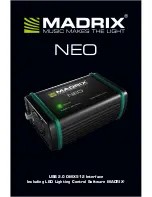
Panel Indicators and Connectors – Front Panel
57
The absolute value of the differential electrometer output voltage (the difference in voltage between
the Working and Reference leads) exceeds 12 V. This condition is known as an E Overload.
The control amplifier has lost control of the cell.
Remember that the Reference 3000 can be operating with compliance limits of
1.5 A at
30 V or
with compliance limits of
3.0 A at
15 V.
The absolute value of the cell current may be trying to exceed the compliance current, or the absolute
value of the counter electrode voltage may be trying to exceed the compliance voltage setting. Either
condition is a Control Overload.
The absolute value of the cell current has exceeded full scale on the current range presently in use.
This condition is known as an I Overload.
An Overload indication does not indicate an instrument failure or system malfunction. Many normal conditions
can light the
Overload
indicator.
For example, transient (temporary) overloads
during
an experiment in which the cell voltage or current is being
stepped or swept are often normal. Consider the case of an infinitely fast voltage step into a perfect capacitor.
In theory, charging the capacitor requires an infinite current. The current spike seen at each step in a stepped-
voltage waveform can easily light the
Overload
LED. The current spike normally decays to near zero before the
actual current and voltage readings are taken.
Overload indications when the cell is being connected or disconnected are also common, and usually do not
indicate a problem. Overloads can also be seen when one of the cell leads is disconnected from the other cell
leads, even though the cell is off. Again, this does not indicate a problem.
A steadily glowing
Overload
LED
during
an experiment most likely indicates a problem is occurring. Possible
causes include:
One of the cell leads is disconnected (this is the most common cause),
A gas bubble in the cell is blocking one of the electrodes,
The potentiostat could be oscillating (see the next chapter).
A glowing red
Overload
LED does not necessarily indicate a system malfunction. The
Overload
LED can illuminate when one or more cell leads are disconnected, without indicating a problem
with the system. The
Overload
LED can often illuminate momentarily during a swept or stepped
experiment. The only
Overload
LED indication that definitely points towards a problem is a continuously
glowing
Overload
LED during an experiment.
















































